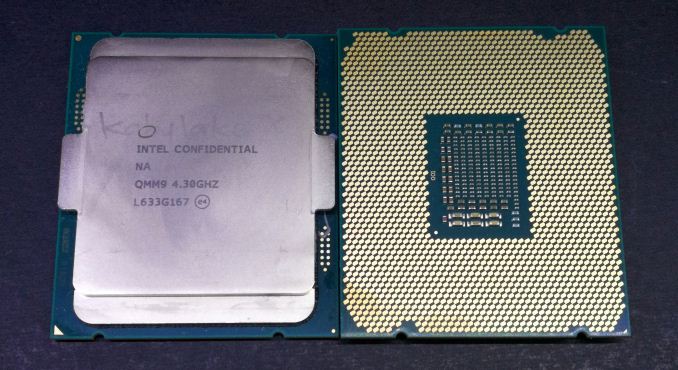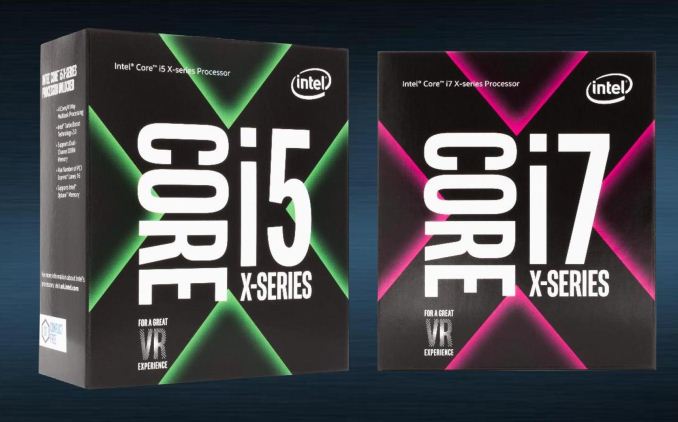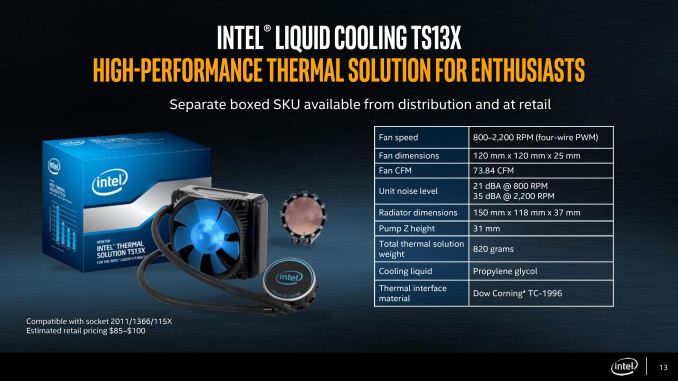The Intel Kaby Lake-X i7 7740X and i5 7640X Review: The New Single-Threaded Champion, OC to 5GHz
by Ian Cutress on July 24, 2017 8:30 AM EST- Posted in
- CPUs
- Intel
- Kaby Lake
- X299
- Basin Falls
- Kaby Lake-X
- i7-7740X
- i5-7640X

Intel’s direction for the high-end desktop space has taken an interesting turn. After several years of iterative updates, slowly increasing core counts and increasing IPC, we have gotten used to being at least one generation of microarchitecture behind the mainstream consumer processor families. There are many reasons for this, including enterprise requirements for long support platforms as well as enterprise update cycles. For 2017, Intel is steering the ship in a slightly different direction, and launching the latest microarchitecture on the HEDT platform. These CPUs don’t feature the high core counts of the other HEDT parts, but offer a higher point up the voltage/frequency scale to be the fastest single thread processors money can buy. They also overclock quite well.
The High-Level Product
Back at Computex, Intel announced its new high-end desktop (HEDT) platform code named Basin Falls. There are three elements to Basin Falls: the new X299 chipset which brings a number of enhancements from the more mainstream consumer line, a set of Skylake-X processors based on the Skylake-SP microarchitecture (and slightly different from the mainstream Skylake-S processors launched in 2015) from 6 cores to 18 cores, and a pair of Kaby Lake-X processors, reusing the Kaby Lake-S silicon launched earlier this year but with a bit more frequency and power consumption.
We covered all three parts in our launch pieces (linked below), but here is a quick recap.
- The Intel Skylake-X Review: Core i9 7900X, i7 7820X and i7 7800X Tested
- Intel Launches Basin Falls: The New Platform and X299 Chipset
- Intel Launches Skylake-X: Bringing 18-core HCC Silicon to Consumers for $1999
- Intel Launches Kaby Lake-X: High Performance
- Our CPU Buyer’s Guide (this link self-updates to the latest version)
Pushing Peak Performance
The main reasons an enthusiast invests in the HEDT platform usually revolve around multi-threaded performance, the need to support multiple graphics cards, and potentially 1.21 jiggabytes of DRAM (ed: you mean 128GB). Kaby Lake-X (KBL-X for short) doesn’t have any of these features that we normally prescribe to HEDT: it only has four cores, not ten or higher; it only supports one GPU at full PCIe speed, up to two in SLI or three in Crossfire if you are willing to have a lower link speed; and it only has dual channel memory for a maximum of 64GB. So why is Intel bringing KBL-X to HEDT? The answer lies primarily in peak performance.
Users that have been in the enthusiast space will have realized that the Holy Grail for PC performance is single threaded (ST) performance. If you master single thread throughput, then arguably the rest is easier, such as scaling out to more cores. There are usually three barriers to high ST-perf: instructions per clock (IPC), frequency and power consumption. A high IPC is fundamental to such a design, as any gains will propagate through the platform, but is becoming a tough job. Over the last few generations, Intel has increased IPC by 3-10% each generation, making a 30-45% increase since 2010 and Sandy Bridge depending on the benchmark, but we’re unlikely to see 50-100% jumps per generation any time soon. Any IPC gains are multiplied through the frequency at which the processor runs at, which can be limited by a combination of things: production process (e.g 14nm), voltage characteristics, stability, yield etc. These features tie directly into power consumption, which increases as a square of voltage and with frequency/capacitance. With some designs, +10% frequency might be possible, but at the cost of +100% power, so there also needs to be a balance to have something marketable that people will want to buy.
Kaby Lake-X is binding Intel’s latest x86 microarchitecture with the highest IPC, at the highest frequency they have ever launched a consumer CPU, for a reasonable power window. Users can overclock another 10% fairly easily, for a slight increase in power. Simply put, Kaby Lake-X is the highest single-thread performing x86 processor out-of-the-box that exists. This is a different take on HEDT compared to previous generations of HEDT CPUs.
With the extra single thread performance, it would appear to appeal to traders who need fast systems, gamers where single thread performance is limiting the frame rate (or minimum frame rates), or science/enterprise workloads where serial code is a limiting factor for simulations or professional applications.
The Core i7 and the Core i5
At the heart, the new KBL-X processors are no different to their mainstream platform KBL-S brethren. The silicon is the same, but potentially binned for a better voltage/frequency curve, and then packaged into the HEDT platform rather than the mainstream platform. Unlike the mainstream processor stack though, Intel is only launching two processors. A Core i7-7740X and a Core i5-7640X.
| Intel Kaby Lake Processors | ||||
| Core i7 | Core i5 | |||
| Core i7-7740X | Core i7-7700K | Core i5-7640X | Core i5-7600K | |
| Socket | LGA2066 | LGA1151 | LGA2066 | LGA1151 |
| Cores/Threads | 4/8 | 4/8 | 4/4 | 4/4 |
| Base Frequency | 4.3 GHz | 4.2 GHz | 4.0 GHz | 3.8 GHz |
| Turbo Frequency | 4.5 GHz | 4.5 GHz | 4.2 GHz | 4.2 GHz |
| TDP | 112 W | 91 W | 112 W | 91 W |
| L2 Cache | 256 KB/core | |||
| L3 Cache | 8 MB | 6 MB | ||
| DRAM Channels | 2 | |||
| DRAM Support | DDR4-2666 | DDR4-2400 | DDR4-2666 | DDR4-2400 |
| Graphics | None | HD 620 | None | HD 620 |
| Price (MSRP) | $350 | $250 | ||
| Price (7/21) | $349 | $309 | $248 | $239 |
| Launched | July 2017 | Jan 2017 | July 2017 | Jan 2017 |
Both CPUs are quad core, with the Core i7 having Hyperthreading for a total of eight threads. The Core i5 does not have hyperthreading, making it the first HEDT processor in the modern Core era to do so. Both will have identical support to their KBL-S siblings, although the increased base/turbo frequencies have resulted in Intel’s TDP increasing from 95W to 112W. The TDP rating is a guide for appropriate cooling: the KBL-S processors were actually very good on their power consumption at stock frequencies, and as shown later, so are the KBL-X processors. Intel could have kept the 95W TDP rating very easily here.
So given what was said in the previous section about peak performance, the Core i7 fits the bill. It has the highest frequencies, and supports hyperthreading for increased performance. It begs the question why the Core i5 exists at all. There are a few guesses as to why:
- For some enterprise users, hyperthreading is not needed
- It is a cheaper entry point into the platform
- It overclocks just as well to perform the same as the Core i7
Intel’s official line is about giving customers options. We will not be seeing a Core i3 on HEDT any time soon, though.
Kaby Lake-X does not come with any bundled cooler, but Intel is promoting its own TS13X liquid cooled loop with the processors. This CLC has been in the market for a good number of years now.
Competition and Market
Because these new KBL-X parts are updates to the KBL-S family, Intel has direct competition with itself. The Core i7-7740X is an alternative to the Core i7-7700K on the mainstream platform, being similar in frequency but giving much higher platform costs.
| Comparison: Intel Core i7-7740X vs Core i7-7700K | ||
| Intel Core i7-7740X |
Features | Intel Core i7-7700K |
| X299 | Platform | Z270 etc |
| LGA2066 | Socket | LGA1151 |
| 4 / 8 | Cores/Threads | 4 / 8 |
| 4.3 / 4.5 GHz | Base/Turbo | 4.2 / 4.5 GHz |
| 16 | PCIe 3.0 Lanes | 16 |
| 256 KB/core | L2 Cache | 256 KB/core |
| 8 MB | L3 Cache | 8 MB |
| 112W | TDP | 95W |
| $349 | Retail Price (7/21) | $309 |
| MSI X299 Raider: $230 ASUS Prime X299-A: $310 GIGABYTE X299-UD4: $249 |
Cheap OC Motherboard Cost |
GIGABYTE Z270-HD3: $114 MSI Z270 SLI PLUS: $136 ASUS TUF Z270-MK2: $120 |
Similar platform builds for the two put an extra $100-150 cost on the motherboard, potentially limiting the usefulness of the new KBL-X parts on paper, as that extra cost of the build as a whole might not warrant another 100 MHz on the turbo frequency. The proof is in the pudding, which is why we are doing this review. The Core i5-7640X against the Core i5-7600K is in a similar situation.
However, there is also AMD to discuss. With the launch of the Ryzen family of processors, There are now significant comparisons to be made between what Intel offers and what AMD offers. Going at a price-for-price comparison, using MSRP prices (not sale prices or distributor prices), the Core i7-7740X squares against AMD’s Ryzen 7 1700.
| Comparison: Intel Core i7-7740X vs AMD Ryzen 7 1700 | ||
| Intel Core i7-7740X |
Features | AMD Ryzen 7 1700 |
| X299 | Platform | X370, B350, A320 |
| LGA2066 | Socket | AM4 |
| 4 / 8 | Cores/Threads | 8 / 16 |
| 4.3 / 4.5 GHz | Base/Turbo | 3.0 / 3.7 GHz |
| 16 | PCIe 3.0 Lanes | 16 |
| 256 KB/core | L2 Cache | 512 KB/core |
| 8 MB | L3 Cache | 16 MB (Victim Cache) |
| 112W | TDP | 65W |
| $349 | Retail Price (7/21) | $270 |
| MSI X299 Raider: $230 ASUS Prime X299-A: $310 GIGABYTE X299-UD4: $249 |
Cheap OC Motherboard Cost |
ASUS Prime B350-Plus: $90 MSI B350 Tomahawk: $100 ASRock AB350 Pro4: $100 |
At this price, both sides have their merits. Intel wins in IPC, which is about 5-15% ahead clock-for-clock, but is also at a higher frequency compounding the difference. In its own attack, AMD wins in cores and threads, offering eight cores and sixteen threads where Intel only offers four cores and eight threads. Intel wins for the IO and chipset, offering 24 PCIe 3.0 lanes for USB 3.1/SATA/Ethernet/storage, while AMD is limited on that front, having 8 PCIe 2.0 from the chipset. Depending on the workload, both sides have merits – AMD will state that it is geared towards more professional multi-threaded workloads, while Intel is geared towards serial code scenarios which still dominate certain tasks. There’s also the platform cost, where the motherboards are $150-$200 cheaper for AMD when looking at cheap overclockable systems.
For the Core i5-7640X, it sits at a similar price to AMD’s Ryzen 5 1600X.
| Comparison: Intel Core i5-7640X vs AMD Ryzen 5 1600X | ||
| Intel Core i5-7640X |
Features | AMD Ryzen 5 1600X |
| X299 | Platform | X370, B350, A320 |
| LGA2066 | Socket | AM4 |
| 4 / 4 | Cores/Threads | 6 / 12 |
| 4.2 / 4.4 GHz | Base/Turbo | 3.6 / 4.0 GHz |
| 16 | PCIe 3.0 Lanes | 16 |
| 256 KB/core | L2 Cache | 512 KB/core |
| 8 MB | L3 Cache | 16 MB (Victim Cache) |
| 112W | TDP | 95W |
| $248 | Retail Price (7/21) | $230 |
| MSI X299 Raider: $230 ASUS Prime X299-A: $310 GIGABYTE X299-UD4: $249 |
Cheap OC Motherboard Cost |
ASUS Prime B350-Plus: $90 MSI B350 Tomahawk: $100 ASRock AB350 Pro4: $100 |
For this review, we have also included numbers for other processors. These include AMD’s Ryzen 7 1800X, which at $499 is an alternative due to the money saved by investing on the AM4 platform; we also have the Skylake-X based Core i7-7800X, which has an MSRP not so far away from the i7-7740X, and opens up the platform with more PCIe lanes, two more cores, but at the expense of single thread performance; and finally the perennial Core i7-2600K from the Sandy Bridge era, for the benchmarks which we have data.
Given everything said above, it would appear Intel has an uphill struggle to convince users that Kaby Lake-X is worth the investment. In this review we will test and see what the performance story is.
Please note that our AMD data is before AGESA 1.0.0.6. We are planning an article with an update of the latest AGESA soon.
Pages In This Review
- 1: Kaby Lake-X Analysis
- 2: Navigating the X299 Minefield: Kaby Lake-X Support
- 3: Test Bed and Setup
- 4: Benchmark Overview
- 5: Benchmarking Performance: CPU System Tests
- 6: Benchmarking Performance: CPU Rendering Tests
- 7: Benchmarking Performance: CPU Web Tests
- 8: Benchmarking Performance: CPU Encoding Tests
- 9: Benchmarking Performance: CPU Office Tests
- 10: Benchmarking Performance: CPU Legacy Tests
- 11: Gaming Performance: Civilization 6 (1080p, 4K, 8K, 16K)
- 12: Gaming Performance: Ashes of the Singularity Escalation (1080p, 4K)
- 13: Gaming Performance: Shadow of Mordor (1080p, 4K)
- 14: Gaming Performance: Rise of the Tomb Raider (1080p, 4K)
- 15: Gaming Performance: Rocket League (1080p, 4K)
- 16: Gaming Performance: Grand Theft Auto V (1080p, 4K)
- 17: Power Consumption and Overclocking to 5 GHz
- 18: Conclusions and Final Words












176 Comments
View All Comments
YukaKun - Monday, July 24, 2017 - link
Hat off to you, Mr Ian. A lot of good and interesting information there.Cheers!
Ian Cutress - Monday, July 24, 2017 - link
Thanks :) This will hopefully become the new CPU testing standard for us. It's all scripted, making benchmarking relatively easy. Sourcing and writing are now the mentally consuming parts.YukaKun - Monday, July 24, 2017 - link
That is nice to know. Will you write an article about the testing itself? Like detailing the process or something along those lines? It would be interesting to know about those little details, for sure!I'm sure you can glue together an article in no time! *wink wink*
Ian Cutress - Monday, July 24, 2017 - link
I've had one half-written about the new 2017 suite and an upcoming project for a couple of weeks. Need to get on it! Coffee time...Dr. Swag - Monday, July 24, 2017 - link
Let's hope you won't be Lake to the party...Cellar Door - Monday, July 24, 2017 - link
What is lake to the party is Intel - it is just so firetrucking sad how they refuse to give customers more for their money. HT should be enabled on all their chips, it is there on the physical chip.I will never buy another Intel cpu - what! You got a problem with that Intel?
leexgx - Monday, July 24, 2017 - link
Ryzen on some r3 cpus don't have SMTLolimaster - Tuesday, July 25, 2017 - link
With the corresponding price, Ryzen 1500X 4c/8t is 90% of the i7 7700 for half the price.Dr. Swag - Tuesday, July 25, 2017 - link
"With the corresponding price, Ryzen 1500X 4c/8t is 90% of the i7 7700 for half the price."This is just incorrect. Ryzen ipc is around 90% of kaby/skylake, but the 7700k oces around 25% higher and also has around a 20% higher out of the box frequency.
Diji1 - Wednesday, July 26, 2017 - link
Uh oh, now they have to swear to never buy an AMD chip ever ever!